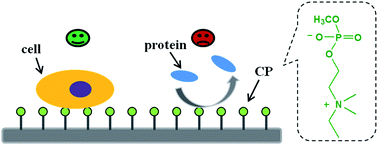A zwitterionic surface with general cell-adhesive and protein-resistant properties
Abstract
Choline phosphate (CP) contains amino and phosphate groups in the reverse order in which they are present in phosphate choline (PC), which is the headgroup of phospholipids in all eukaryotic cell membranes. Here we used HeLa and L929 cells to study the general interaction between CP-modified surfaces and cells/proteins. The results of cell counting kit-8 (CCK-8), confocal laser scanning (CLSM) and scanning electron microscopy (SEM) indicated that CP-modified surfaces could improve cell adhesion by almost three times than unmodified surfaces through a unique CP–PC interaction with PC headgroups of the cell membrane. The mechanism for this interaction was the formation of a quadrupole from two quaternary nitrogen–phosphorus pairs. Moreover, the results of fibrinogen and fetal bovine serum protein adsorption experiments indicated that CP-modified surfaces could also resist nonspecific protein adsorption due to the zwitterionic property of the CP group. Therefore, this surface offers a general strategy for the preparation of biomaterials with both cell-adhesive and protein-resistant properties.


 Please wait while we load your content...
Please wait while we load your content...